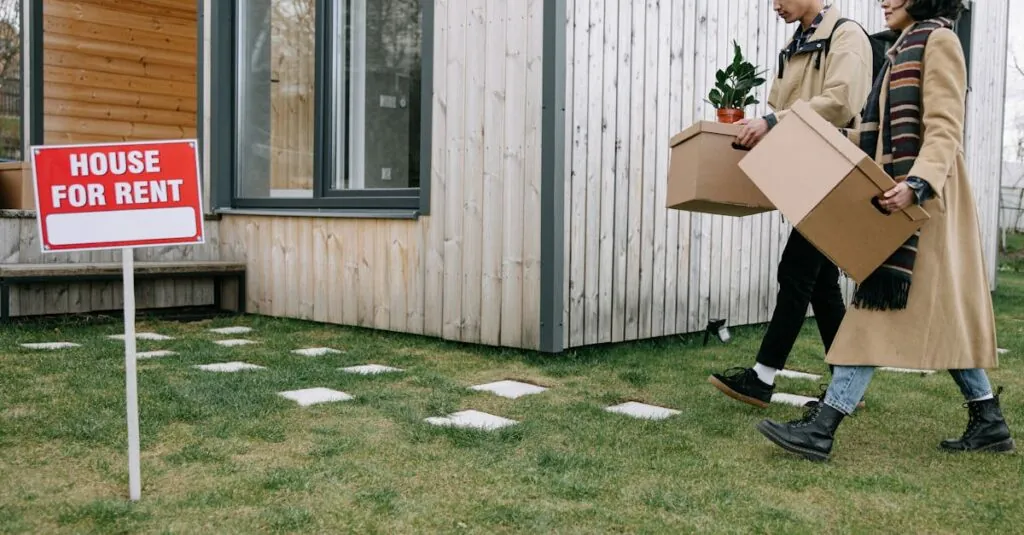Investing in rental property can feel like diving into a pool of cash—only to realize it’s empty. One of the biggest hurdles for aspiring landlords is the down payment. It’s that pesky upfront cost that can make anyone second-guess their dreams of becoming the next real estate mogul. But fear not! Understanding down payments can unlock the door to your future income streams.
Table of Contents
ToggleUnderstanding Down Payment For Rental Property
Down payments play a crucial role in acquiring rental properties. They serve as a significant upfront investment and can shape overall financing options.
Importance Of Down Payments
Down payments significantly influence loan approval. They lower the lender’s risk, which may lead to better interest rates and terms. Higher down payments demonstrate financial stability, increasing the likelihood of being approved for financing. Additionally, a larger down payment decreases monthly mortgage payments, allowing for improved cash flow. Potential landlords gain peace of mind knowing that a strong down payment can lead to favorable loan conditions.
Typical Down Payment Amounts
Typical down payment amounts for rental properties vary based on lender requirements and property types. For traditional investment properties, 20% of the purchase price is common. Some lenders might allow lower down payments, often around 15%, but this can result in higher monthly payments or Private Mortgage Insurance (PMI). Financing options may differ. FHA loans offer a down payment of 3.5%, though stricter approval standards apply. Investors should thoroughly research and understand their financial situation before deciding on a down payment amount.
Types Of Down Payments
Understanding the types of down payments helps potential landlords navigate their options effectively. Two main categories exist: traditional financing options and alternative financing options.
Traditional Financing Options
Conventional mortgages typically require a 20% down payment for rental properties, which reduces lender risk. Smaller down payments may be available through some lenders, especially if the borrower has good credit. Investors often explore Fixed-Rate Mortgages, which offer stability with consistent monthly payments. Adjustable-Rate Mortgages may also be an option, featuring lower initial rates that can change over time. Government-backed loans, such as FHA or VA loans, provide reduced down payment requirements but include specific eligibility criteria.
Alternative Financing Options
Creative financing offers various choices for those seeking less conventional avenues. Lease options permit potential buyers to lease a property with an option to purchase later, often requiring minimal upfront payments. Seller financing allows sellers to act as lenders, allowing buyers to negotiate down payment terms directly. Additionally, crowdfunding platforms have emerged, enabling multiple investors to pool funds for down payments collectively. Hard money loans provide quick access to funds, although interest rates are generally higher. These alternative methods can circumvent standard requirements, expanding access to real estate investments.
Factors Influencing Down Payment Requirements
Several elements influence down payment requirements for rental properties. Understanding these factors can help potential investors make informed decisions.
Credit Score Impacts
Credit score plays a significant role in determining down payment amounts. Generally, higher credit scores lead to lower down payment requirements. Lenders perceive lower risk when borrowers have strong credit histories, possibly reducing the down payment to as low as 3% for certain loans. On the contrary, lower credit scores may mandate larger down payments, often reaching 25% or more, to offset perceived risks. Maintaining a solid credit score can enhance opportunities for favorable financing options.
Property Type Considerations
Property type significantly affects down payment requirements. Single-family homes typically require a standard down payment of around 20%. Multi-family properties or mixed-use buildings often demand higher down payments, sometimes exceeding 25%, due to increased risk factors. Additionally, investment properties with unique characteristics may also lead to different lending criteria, impacting required down payments. It’s essential to examine the specific characteristics of the property when planning for up-front costs.
Steps To Secure A Down Payment
Securing a down payment involves strategic planning and resource management. Investors can employ various methods to gather the necessary funds.
Savings Strategies
Establish a dedicated savings account for rental property down payments. Focusing on consistent contributions helps grow the balance over time. Set a specific savings goal based on the desired down payment percentage. Create a monthly budget that prioritizes savings, cutting non-essential expenses to reach targets sooner. Consider automating transfers to the savings account after each paycheck. Additionally, increasing income through side jobs or freelance work can accelerate savings growth.
Utilizing Grants And Assistance Programs
Many local and state governments offer grants and assistance programs for aspiring investors. Research these options thoroughly to identify eligibility criteria and application processes. Programs like the HOME Investment Partnerships Program provide funds that reduce down payment burdens. Some nonprofits also offer assistance specifically for first-time real estate investors. Engaging with community resources may unveil additional financial support avenues. This proactive approach allows potential landlords to leverage available funds effectively.
Navigating the down payment landscape for rental properties can seem daunting. However with the right knowledge and strategies in place, aspiring landlords can overcome this barrier. Understanding the various financing options and factors that influence down payment requirements is essential for making informed decisions. By prioritizing savings and exploring available assistance programs, investors can significantly ease the financial burden. Ultimately this proactive approach not only opens the door to real estate opportunities but also sets the stage for long-term financial success in the rental market.





